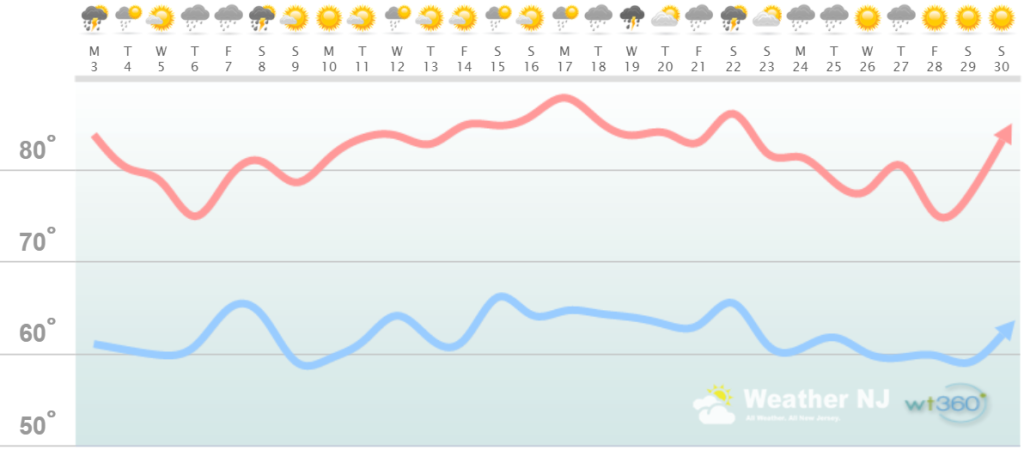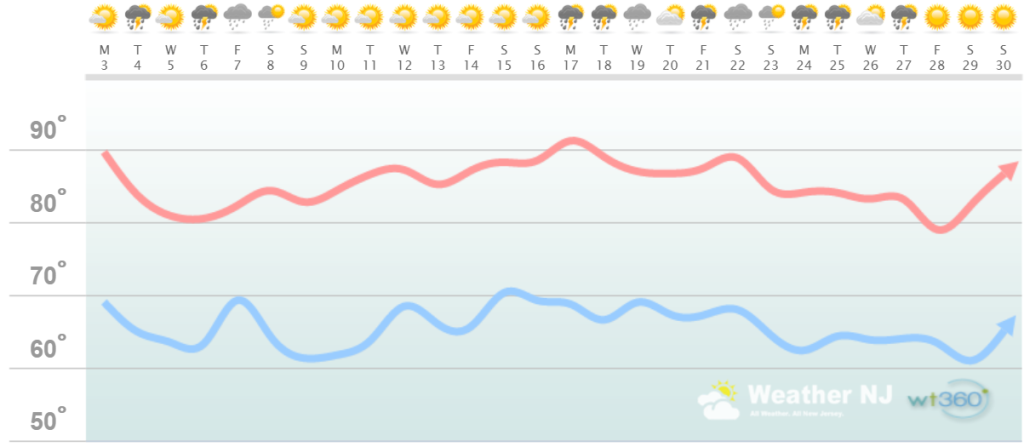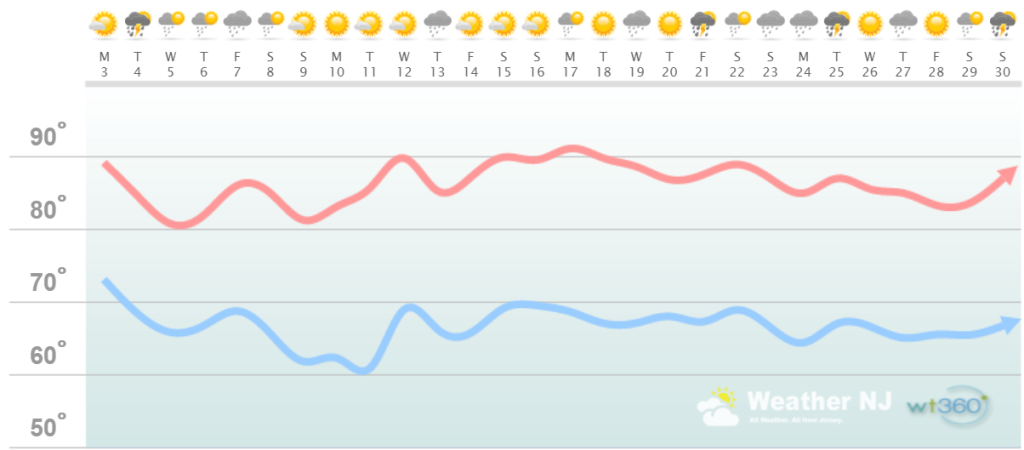July 2017 Discussion

It’s time to harness the WeatherTrends360 proprietary weather algorithms to see how the rest of July 2017 should play out. But first lets break New Jersey into proper climatological regions. We have the higher elevations of NNJ/NWNJ, the interior coastal plain (SWNJ through CNJ and into NENJ – Newark Basin), and the coastal regions (most of SENJ coast – Sandy Hook down and around Cape May into Delaware Bay). I’ll be representing each climatological region with a 28-day graph from weathertrends360 data followed by a brief discussion.
Please keep in mind that these algorithms are documented with an 84% verification rate and are based on oceanic water cycles, time table series and very complex mathematics. The best takeaway from this data are general trends (cool vs warm, rainy vs dry, etc). I’m always hesitant to forecast specific surface conditions (rainfall amounts, snowfall amounts, winds, etc) beyond the 4-7 day forecasting period. But temperature and precipitation trends is what WeatherTrends360 does best with their proprietary mathematical analysis derived from over 150 years of reactive pattern data. For this reason, let’s call this a long-range discussion of expectations rather than a locked-in forecast.
Higher Elevations of NNJ/NWNJ
(Sussex, Warren, Hunterdon, Morris, N. Somerset, and N. Passaic) – Known for little to no Atlantic Ocean influence, colder-snowier winters, and drier conditions in general when compared to the coast. This rnown to get hot when high pressure sits overhead during the summer and bitterly cold during Arctic outbreaks in the winter. Elevation is a major influence that separates this micro-climate from the rest of New Jersey. This region extends into NE PA (Poconos) and parts of NY State (Catskills).
Higher Elevation Discussion: This region should see high temperatures in the upper-70s/80s with the warmest period likely occurring mid-month. Overnight lows should hover in the low-to-mid 60s with a few nights of dipping into the upper-50s. Rain and thunderstorm activity appear pretty run-of-mill for July. Your afternoons always have a chance of a pop-up, especially when sea breeze fronts whip up.
Interior Coastal Plain from SWNJ-CNJ-NENJ
(Salem, Gloucester, Camden, W. Burlington, Mercer, W. Monmouth, Middlesex, S. Somerset, Union, Essex, Hudson, Bergen, and S. Passaic) – Known for naturally higher temperatures due to lower elevations away from the oceanic influence. This region is also known as “heat island” due to transportation (I-95 corridor), smog, abundant asphalt, concrete, and other man-made substances that naturally absorb and retain heat moreso than natural protected land. This is why excessive heat warnings and air quality alerts are more common in this region. SWNJ always tends to run a few degrees warmer than NENJ but this region is very similar otherwise in micro-climate due to the parallel nature of the Appalachian Mountain elevations to the NW. The same micro-climate can be extended into SE PA and NE MD which tends to run just a little stormier than NJ. This however is what makes up the interior coastal plain.
Interior Coastal Plain Discussion: This region should see high temperatures ranging from 80s to lower-90s with the warmest period likely occurring mid-month. Overnight lows should hover in 60s. Rain and thunderstorm activity appear pretty run-of-mill for July. Your afternoons always have a chance of a pop-up, especially when sea breeze fronts whip up.
Coastal Regions of SENJ
(Cumberland, Cape May, Atlantic, E. Burlington, Ocean, and E. Monmouth) – Known for tremendous influence from the Atlantic Ocean. Oceanic influence keeps this zone cooler in the summer and warmer in the winter than the interior coastal plain and especially the higher elevations of NWNJ. In the summer, sea breeze fronts back into the coast and can ignite thunderstorms if enough instability is present. The cooler marine air slides under the hot air to the W and provides additional atmospheric lifting. This is both why it’s 5-15 degrees cooler at the shore than the Philly-Trenton area and why near-stationary thunderstorms can form along the coast capable of producing localized flash flooding. In the winter, the ocean is warmer than interior regions which plays a huge role in rain vs. snow—highly dependent on wind direction. When the winds chance from NE to N/NE, that’s usually when temps crash and change rain over to snow. Regardless, this micro-climate is well known, well documented and well expressed. This region extends into most of Delaware as well.
Coastal Region Discussion: This region should see high temperatures in the upper-70s/mostly 80s with the warmest period likely occurring mid-month. Sea breeze front influence can easily take a warm day into pleasant land during afternoon hours. Overnight lows should hover in the 60s with a few nights of struggling to dip below 70. Rain and thunderstorm activity appear pretty run-of-mill for July. Your afternoons always have a chance of a pop-up, especially when sea breeze fronts whip up.
Tropical Discussion: We already have an area of tropical investigation (Invest 94L). With coastal sea surface temperatures colder than average (due to upwelling), I’m highly suspect in any tropical system making landfall on the Mid-Atlantic US coast. There’s no reason why the system can’t develop and head towards us though before re-curving away and out to sea. Try to stay calm as many will be hyping and speculating doomsday scenarios. Everyone have a great July and please be safe! JC
Weathertrends360 is a complete, global, web solution to help retailers and suppliers capitalize on the weather and its influence on sales and marketing plans up to a year ahead. Learn how to become PROACTIVE vs REACTIVE with the weather in every phase of your business – how much inventory to buy/produce, where to allocate more/less, when to run weather-optimized advertising/marketing campaigns – weathertrends360 can help you determine all of this in minutes! 84% independently audited accuracy for both short-term and year-ahead forecasts for temperature and precipitation.
Jonathan Carr (JC) is the founder and sole operator of Weather NJ, New Jersey’s largest independent weather reporting agency. Since 2010, Jonathan has provided weather safety discussion and forecasting services for New Jersey and surrounding areas through the web and social media. Originally branded as Severe NJ Weather (before 2014), Weather NJ is proud to bring you accurate and responsible forecast discussion ahead of high-stakes weather scenarios that impact this great garden state of ours. All Weather. All New Jersey.™ Be safe! JC












